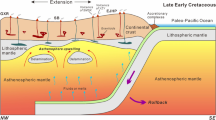Abstract
Tourmaline-rich rocks associated with clastic metasedimentary rocks of Carboniferous age occur in the Cinco Villas massif, western Pyrenees. Three types of tourmaline-rich rocks were distinguished: (1) Fine-grained stratiform tourmaline-rich rocks, which are associated with carbonaceous metapelites (TR1); (2) stratabound tourmaline-rich rocks, associated with metapelites in the contact aureole of the Aya granitoid pluton (TR2); (3) stratabound to massive tourmaline-rich rocks, associated with psammopelites in contact with granites and pegmatites (TR3). Tourmalines belong to the schorl–dravite solid solution series and have a wide compositional range, from nearly end-member dravite for TR1 tourmalines to schorl for TR3 tourmalines; TR2 tourmalines have intermediate compositions. The Fe/(Fe+Mg) typically varies between 0.02 and ≈0.55, increasing from TR1 to TR3. The TR1 tourmalines commonly display a discontinuous chemical zoning with Fe-rich green cores (8–8.5% FeO) and Mg-rich colorless rims (10–11% MgO). In contrast, crystals that exhibit fine growth lamellae appear to lack significant chemical zoning. Oxygen and hydrogen isotope compositions also reveal major differences between TR1 and TR3 tourmalines, the former displaying heavier δ18O values (17.7–19‰) and δD values (−35 to −42‰) than TR3 tourmalines 11 to 13‰ and −47 to −76‰, respectively. The TR2 tourmalines show intermediate values of 11.3 to 14.6‰ for δ18O and −40 to −55‰ for δD. Linear and continuous chemical variations obtained for major and trace elements of the whole rocks reflect mixing between clay-rich and quartz-rich end-members, indicative that some tourmaline-rich rocks contain a significant detrital component. Chondrite normalized REE (rare earth element) patterns of tourmaline-rich rocks are similar to those of surrounding unaltered clastic metasediments, except for some TR1 rocks which are characterized by low contents of ΣREE. Mass-balance calculations show that tourmaline-forming processes plus metamorphism led to mass and volume changes at mesoscopic scales (≈10% for the TR1 tourmalinites). Silicon, Fe, Mn, and REE elements were partially lost from sedimentary rocks, whereas Mg and particularly B were added to pelitic sediments. Available data, nevertheless, do not allow an assessment of the boron source. Formation of the TR1 tourmaline-rich rocks probably was the net result of several processes, including direct precipitation from B-rich hydrothermal fluids or colloids, early diagenetic reactions of carbonaceous pelitic sediments with these fluids, and subsequent recrystallization during regional metamorphism. The TR2 tourmaline-rich rocks mainly developed by metamorphic recrystallization of TR1. Tourmaline-rich rocks and veins adjacent to pegmatites and granitic rocks (TR3) are the result of boron metasomatism; the primary boron having been recycled from stratiform tourmalinites during regional metamorphism and magmatism.
Similar content being viewed by others
Author information
Authors and Affiliations
Additional information
Received: 18 November 1996 / Accepted: 25 April 1997
Rights and permissions
About this article
Cite this article
Pesquera, A., Velasco, F. Mineralogy, geochemistry and geological significance of tourmaline-rich rocks from the Paleozoic Cinco Villas massif (western Pyrenees, Spain). Contrib Mineral Petrol 129, 53–74 (1997). https://doi.org/10.1007/s004100050323
Issue Date:
DOI: https://doi.org/10.1007/s004100050323




